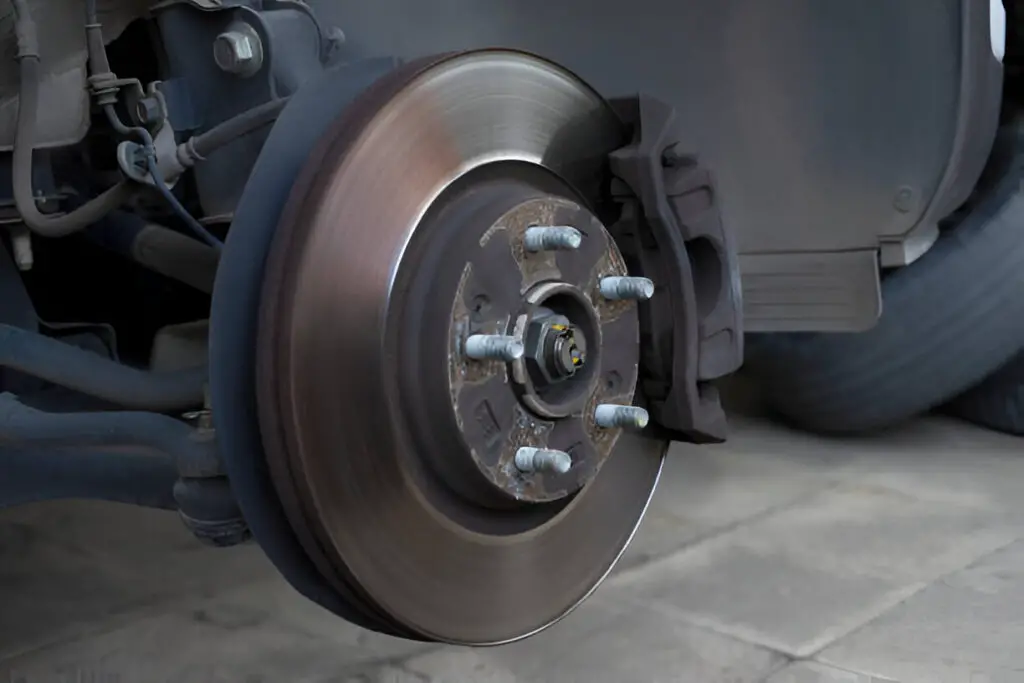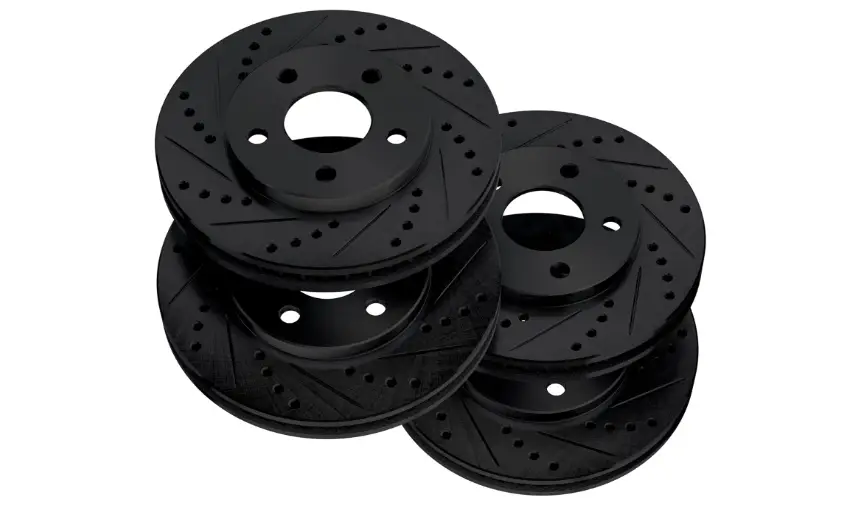Brake rotors are essential components of your car’s braking system, working with brake pads to slow and stop the vehicle by creating friction. Different types, such as solid, vented, slotted, and drilled rotors, offer varying levels of performance, heat dissipation, and durability.
When it comes to ensuring the safety and performance of your car, one of the most crucial components you need to pay attention to is the brake system. Among the many parts of the braking system, brake rotors play a key role in stopping your vehicle safely and efficiently.
In this blog post, we’ll take a deep dive into what brake rotors are, how they function, the different types available, and how to choose the right rotors for your vehicle. We’ll also cover the signs of rotor wear and answer some common FAQs.

Contents
What Are Brake Rotors?
Brake rotors, also known as brake discs, are circular metal components that are directly connected to your car’s wheel hubs. They work with brake pads to slow down and stop your vehicle when you apply pressure to the brake pedal. When the brake pads clamp down on the spinning rotors, friction is created, which ultimately reduces the speed of the vehicle and brings it to a stop.
Rotors are usually made from cast iron, but there are also high-performance materials like carbon composite, ceramic, and carbon fiber reinforced ceramic that are used in sports and luxury cars.
Types of Brake Rotors
When selecting brake rotors, it’s essential to understand the different types available on the market, as each type offers specific advantages. Below are the most common types of brake rotors:
1. Solid/Standard Rotors
Solid rotors are the most basic type of brake rotors. They are made of a solid piece of metal and are typically found on everyday commuter vehicles. While they do their job of stopping the car, they tend to heat up quickly under heavy braking, which can lead to brake fade.
- Best for: Everyday driving, smaller vehicles.
- Pros: Cost-effective, reliable for normal driving conditions.
- Cons: Less heat dissipation, not suitable for heavy-duty or performance vehicles.

2. Vented Rotors
Vented rotors have a series of vanes or fins between two layers of metal. This design allows for better heat dissipation compared to solid rotors, as air flows through the vents while the rotors spin. Vented rotors are typically used in the front brakes, where the majority of braking force is applied.
- Best for: Vehicles used for daily driving and light towing.
- Pros: Better cooling and less prone to warping.
- Cons: Slightly more expensive than solid rotors.

3. Slotted Rotors
Slotted rotors feature shallow grooves or slots on the surface. These slots help evacuate gas, heat, and debris away from the braking surface, improving braking performance in demanding conditions. However, slotted rotors can wear down brake pads faster due to the aggressive nature of the slots.
- Best for: Off-road vehicles, trucks, and performance cars.
- Pros: Enhanced braking performance, less prone to fade.
- Cons: Increased wear on brake pads, slightly noisier.

4. Drilled Rotors
Drilled rotors have holes drilled through them, which allow heat, water, and gases to escape from the braking surface. This makes them ideal for wet or performance driving conditions. However, drilled rotors can be prone to cracking under extreme stress, such as heavy braking at high speeds.
- Best for: High-performance or racing vehicles.
- Pros: Improved heat dissipation, better in wet conditions.
- Cons: Prone to cracking under extreme conditions, more expensive.
5. Drilled and Slotted Rotors
As the name suggests, these rotors combine the features of both drilled and slotted designs. They provide excellent heat dissipation, prevent gas and water build-up, and deliver superior stopping power. Drilled and slotted rotors are often used in high-performance vehicles and trucks.
- Best for: Performance vehicles, heavy-duty trucks, and vehicles used for towing.
- Pros: Best performance in terms of heat dissipation and debris removal.
- Cons: Expensive, increased wear on brake pads, potential for cracking under extreme stress.
6. Carbon-Ceramic Rotors
Carbon-ceramic rotors are the pinnacle of brake rotor technology. Made from a blend of carbon fiber and ceramic, these rotors offer extreme heat resistance, superior braking performance, and incredible durability. Carbon-ceramic rotors are commonly found in high-end sports cars and supercars.
- Best for: High-performance and luxury vehicles.
- Pros: Lightweight, exceptional heat resistance, and long lifespan.
- Cons: Extremely expensive, overkill for daily drivers.
How to Choose the Right Brake Rotors for the Car
When it comes to selecting the right brake rotors, you need to consider several factors:
- Driving Conditions: The type of driving you do plays a significant role in choosing brake rotors. If you mostly drive in the city or on highways, solid or vented rotors may suffice. However, if you drive in extreme conditions—such as off-roading, towing, or racing—slotted, drilled, or performance rotors may be a better choice.
- Budget: Brake rotors come in a wide range of prices. While premium options like carbon-ceramic rotors are available, they can be very costly. For most drivers, vented or slotted rotors offer a good balance between performance and cost.
- Vehicle Type: The size, weight, and performance capabilities of your vehicle will also determine which rotors are suitable. Trucks, SUVs, and performance vehicles often require heavy-duty rotors to handle the additional stress and weight.
- OEM vs. Aftermarket: Original equipment manufacturer (OEM) rotors are designed specifically for your vehicle, while aftermarket rotors may offer additional features like better heat dissipation or enhanced performance. It’s crucial to ensure that aftermarket rotors meet the same standards as OEM parts.
Frequently Asked Questions
Here are FAQs about brake rotors –
How often should I replace my brake rotors?
Brake rotors typically last between 30,000 to 70,000 miles, but this can vary depending on driving habits, road conditions, and the type of rotors. It’s best to have them inspected during routine brake checks.
Can I replace just the brake pads and not the rotors?
In some cases, you can replace only the brake pads if the rotors are still in good condition. However, if the rotors are warped, cracked, or heavily worn, it’s recommended to replace them along with the pads. Read more about Why Replace Rotors When Replacing Brake Pads?
What happens if I drive with bad rotors?
Driving with worn or damaged rotors can reduce braking efficiency, increase stopping distance, and potentially lead to brake failure. It’s essential to address any rotor issues promptly to avoid accidents.
Are slotted or drilled rotors better?
It depends on your driving needs. Drilled rotors perform better in wet conditions, while slotted rotors are more effective at removing debris and gases. Both options offer improved performance over standard rotors.
Can I resurface my brake rotors instead of replacing them?
Resurfacing, or turning, can extend the life of your rotors if they are still thick enough and not severely damaged. However, resurfacing thins the rotor, which can make it more susceptible to warping in the future.
Conclusion
Brake rotors are a vital component of your vehicle’s braking system. Choosing the right type of rotor for your driving habits and vehicle can improve your car’s braking performance, safety, and longevity. By understanding the various types of brake rotors and knowing the signs of wear, you can make an informed decision that ensures your car stays in top shape for years to come. Always consult your mechanic or refer to your vehicle’s manual to ensure you’re selecting the correct rotors for your specific model.